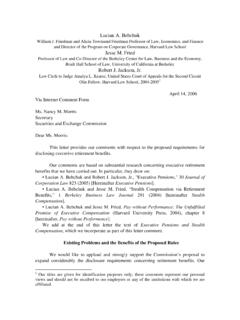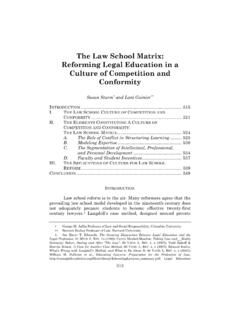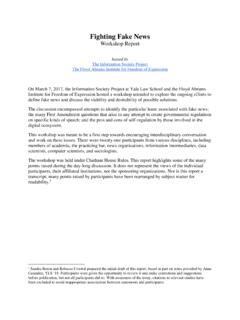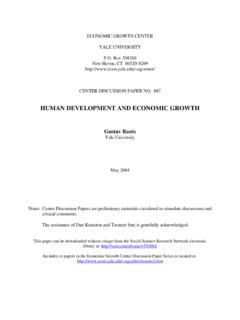Transcription of ISSN 1936-5349 (print) HARVARD - Harvard Law School
1 ISSN 1936-5349 (print) ISSN 1936-5357 (online) HARVARD JOHN M. OLIN CENTER FOR LAW, ECONOMICS, AND BUSINESS THE ESSENTIAL ELEMENTS OF CORPORATE LAW: WHAT IS CORPORATE LAW? John Armour, Henry Hansmann, Reinier Kraakman Discussion Paper No. 643 7/2009 HARVARD Law School Cambridge, MA 02138 This paper can be downloaded without charge from: The HARVARD John M. Olin Discussion Paper Series: The Social Science Research Network Electronic Paper Collection: ####### This paper is also a discussion paper of the John M. Olin Center s Program on Corporate Governance. The Essential Elements of Corporate Law What is Corporate Law?
2 John Armour University of Oxford - Faculty of Law; Oxford-Man Institute of Quantitative Finance; European Corporate Governance Institute (ECGI) Henry Hansmann yale Law School ; European Corporate Governance Institute (ECGI) Reinier Kraakman HARVARD Law School ; John M. Olin Center for Law; European Corporate Governance Institute Abstract: This article is the first chapter of the second edition of The Anatomy of Corporate Law: A Comparative and Functional Approach, by Reinier Kraakman, John Armour, Paul Davies, Luca Enriques, Henry Hansmann, Gerard Hertig, Klaus Hopt, Hideki Kanda and Edward Rock (Oxford University Press, 2009). The book as a whole provides a functional analysis of corporate (or company) law in Europe, the , and Japan.
3 Its organization reflects the structure of corporate law across all jurisdictions, while individual chapters explore the diversity of jurisdictional approaches to the common problems of corporate law. In its second edition, the book has been significantly revised and expanded. As the book's introductory chapter, this article describes the functions and boundaries of corporate law. We first detail the economic importance of the corporate form's hallmark features: legal personality, limited liability, transferable shares, delegated management, and investor ownership. We then identify the major agency problems that attend the corporate form, and that, therefore, corporate law must address: conflicts between managers and shareholders, between controlling and minority shareholders, and between shareholders as a class and non-shareholder constituencies of the firm such as creditors and employees.
4 In our view, corporate law serves in part to accommodate contract and property law to the corporate form and, in substantial part, to address the agency problems that are associated with this form. We next consider the role of law in structuring corporate affairs so as to achieve these goals: whether, and to what extent standard forms - as opposed, on the one hand, to private contract, and on the other, to mandatory rules - are needed, and the role of regulatory competition. Whilst the core features of corporate law are present in all - or almost all - legal systems, different systems have made different choices regarding the form and content of many other aspects of their corporate laws.
5 To assist in explaining these, we review a range of forces that shape the development of corporate law, including domestic share ownership patterns. These forces operate differently across countries, implying that in some cases, complementary differences in corporate laws are functional. However, other such differences may be better explained as a response to purely distributional concerns. JEL Classifications: D23, G32, G34, G38, K22, M14 11 What is Corporate Law? 2009 JOHN ARMOUR, HENRY HANSMANN, and REINIER KRAAKMAN INTRODUCTION What is the common structure of the law of business corporations or, as it would be put in some jurisdictions, company law across different national jurisdictions?
6 Although this question is rarely asked by corporate law scholars, it is critically important for the comparative investigation of corporate law. Recent scholarship often emphasizes the divergence among European, American, and Japanese corporations in corporate governance, share ownership, capital markets, and business But, notwithstanding the very real differences across jurisdictions along these dimensions, the underlying uniformity of the corporate form is at least as impressive. Business corporations have a fundamentally similar set of legal characteristics and face a fundamentally similar set of legal problems in all jurisdictions.
7 Consider, in this regard, the basic legal characteristics of the business corporation. To anticipate our discussion below, there are five of these characteristics, most of which will be easily recognizable to anyone familiar with business affairs. They are: legal personality, limited liability, transferable shares, delegated management under a board structure, and investor ownership. These characteristics respond in ways we will explore to the economic exigencies of the large modern business enterprise. Thus, corporate law everywhere must, of necessity, provide for them. To be sure, there are other forms of business enterprise that lack one or more of these characteristics.
8 But the remarkable fact and the fact that we wish to stress is that, in market economies, almost all large-scale business firms adopt a legal form that possesses all five of the basic characteristics of the business corporation. Indeed, most small jointly-owned firms adopt this corporate form as well, although sometimes with deviations from one or more of the five basic characteristics to fit their special needs. It follows that a principal function of corporate law is to provide business enterprises with a legal form that possesses these five core attributes. By making this form widely available and user-friendly, corporate law enables entrepreneurs to transact easily through the medium of the corporate entity, and thus lowers the costs of conducting business.
9 Of course, the number of provisions that the typical corporation statute2 devotes to defining the corporate form is likely to be only a small part of the statute as a whole. Nevertheless, these are the provisions that comprise the legal core of corporate law that is shared by every jurisdiction. In this Chapter, we 1 See, , Ronald J. Gilson and Mark J. Roe, Understanding the Japanese Keiretsu: Overlaps Between Corporation Governance and Industrial Organization, 102 yale LAW JOURNAL 871 (1993); Mark J. Roe, Some Differences in Corporation Structure in Germany, Japan, and the United States, 102 yale LAW JOURNAL 1927 (1993); Bernard S.
10 Black and John C. Coffee, Hail Britannia? Institutional Investor Behavior Under Limited Regulation, 92 MICHIGAN LAW REVIEW 1997 (1994); COMPARATIVE CORPORATE GOVERNANCE: ESSAYS AND MATERIALS (Klaus J. Hopt and Eddy Wymeersch (eds.), 1997); and Mark J. Roe, POLITICAL DETERMINANTS OF CORPORATE GOVERNANCE (2003). 2 We use the term corporation statute to refer to the general law that governs corporations, and not to a corporation s individual charter (or articles of incorporation , as that document is sometimes also called). 2briefly explore the contracting efficiencies (some familiar and some not) that accompany these five features of the corporate form, and that, we believe, have helped to propel the worldwide diffusion of the corporate form.



















